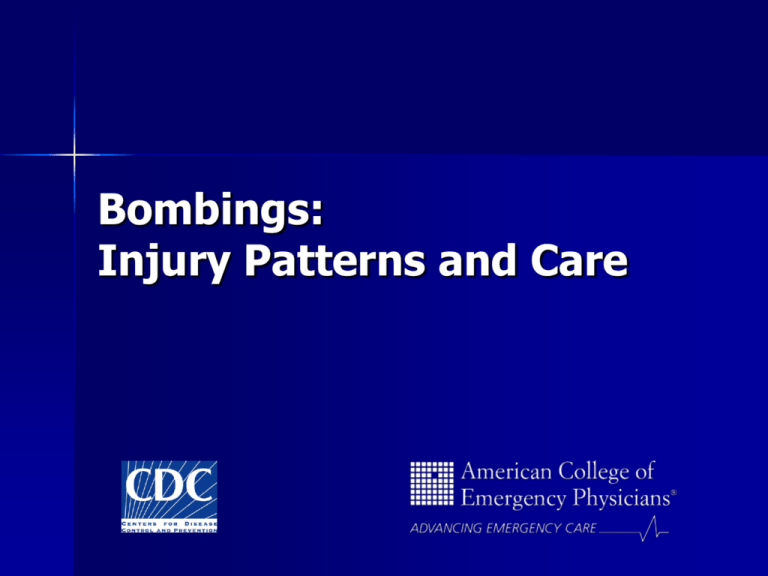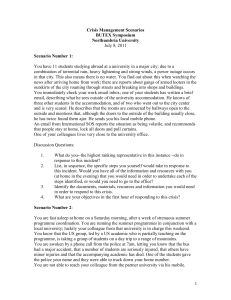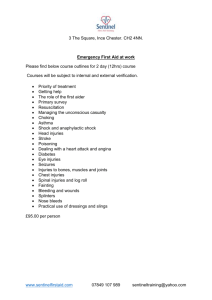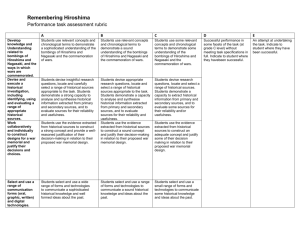Bombings: Injury Patterns and Care
advertisement

Bombings: Injury Patterns and Care This project was funded by the Centers for Disease Control and Prevention (CDC) under Cooperative Agreement U17/CCU524163-01, “Linkages of Acute Care and EMS to State and Local Injury Prevention Programs for Terrorism Preparedness and Response.” The Bombings: Injury Patterns and Care curriculum was developed through the Linkages of Acute Care and EMS to State and Local Injury Prevention Programs project that was funded by the Centers for Disease Control and Prevention (CDC). The American College of Emergency Physicians (ACEP) served as the lead grantee for the project along with the following six other organizations: American Medical Association (AMA) American Trauma Society (ATS) National Association of EMS Physicians (NAEMSP) National Association of EMT’s (NAEMT) National Association of State EMS Officials (NASEMSO) National Native American EMS Association (NNAEMSA) Bombings: Injury Patterns and Care 3 A task force was established with representative experts from emergency medicine including physicians, surgeons, nursing, and EMS. Core competencies and knowledge objectives were developed using a consensus approach. A writing group then developed teaching objectives and course content based on the core competencies. The Bombings: Injury Patterns and Care curriculum is designed to be the minimum content that should be included in any allhazards disaster response training program. This content is designed to update the student with the latest clinical information regarding blast related injuries from terrorism. Bombings: Injury Patterns and Care 4 American College of Emergency Physicians (ACEP) Grant Staff – – – – – – – Kathryn H. Brinsfield, MD, MPH, FACEP, Chair, Curriculum on Traumatic Injuries from Terrorism Task Force (CO-TIFT) Rick Murray, EMT-P, EMS and Disaster Preparedness Director, Principle Investigator Marshall Gardner, EMT-P, EMS and Disaster Preparedness Manager Diana S. Jester, EMS and Disaster Response Coordinator Cynthia Singh, MS, Grants and Development Manager Kathryn Mensah, MS, Grants Administrator Mary Whiteside, PhD, Curriculum Development Consultant Centers for Disease Control and Prevention (CDC) Staff – – – – – Richard C. Hunt, MD, FACEP, Director, Division of Injury Response, National Center for Injury Prevention and Control Scott M. Sasser, MD, FACEP, Consultant, Division of Injury Response, National Center for Injury Prevention and Control Ernest E. Sullivent, III, MD, Medical Officer, Division of Injury Response, National Center for Injury Prevention and Control Paula Burgess, MD, MPH, Team Leader, Division of Injury Response, National Center for Injury Prevention and Control Jane Mitchko, MEd, CHES, Health Communications Specialist, Division of Injury Response, National Center for Injury Prevention and Control 12/06 Bombings: Injury Patterns and Care 5 Discussion Topics Background Explosive Events Blast Injuries – Primary, Secondary, Tertiary, Quaternary Crush Injuries and Compartment Syndrome Military Experience Special Considerations Psychological Issues Bombings: Injury Patterns and Care 6 Background Bombings: Injury Patterns and Care 7 Background Terrorism can be defined as containing four key elements: – – – – Premeditated Political Aimed at civilians Carried out by sub-national groups Bombings: Injury Patterns and Care 8 Background Explosive use increasing in terrorist events Result in mass casualty incidents Recent examples – – – – – Mumbai (2006) Tel Aviv (2006) London subway (2005) Madrid subway (2004) Tel Aviv (2001) Bombings: Injury Patterns and Care 9 Background: Historical Perspective 1968-1999 – 7000 international terrorist bombings 1969-1980 – 187 bombings in Northern Ireland 1980-2001 – 324 criminal bombing events in the US 2001-2003 – 500 International terrorist bombings 2005 – 399 International terrorist bombings Sources: Frykberg ER, Tepas JJ; US Departments of State, Justice; Terrorism Research Centre Bombings: Injury Patterns and Care 10 Background: Blast Devices Photo used with permission of MAJ Benjamin Gonzalez, MD Bombings: Injury Patterns and Care 11 Background: Blast Devices Improvised explosive devices (IEDs) – – – – Car and truck bombs (Oklahoma City, World Trade Center I) Letter and parcel bombs (Idaho “Unabomber”) Pipe bombs (Atlanta Olympics) Backpack and satchel bombs (Israel, London) Incendiary bombs – Airplane bombs (World Trade Center II, Pentagon) Rocket propelled grenades (RPGs) Surface to air missiles (SAMs) Enhanced blast devices Bombings: Injury Patterns and Care 12 Background: Blast Devices IEDs Improvised/“homemade” explosive devices Made from explosives, commercial blasting supplies, or fertilizer and household ingredients Designed to cause injury and death Often packed with metal objects such as nails or ball bearings; could contain toxic chemicals or radiological materials (dirty bomb) Bombings: Injury Patterns and Care 13 Background: Blast Agents High-order explosive: HE Low-order explosive: LE Nitroglycerin (NTG) Petroleum products (“Molotov cocktail”) Dynamite Gunpowder Plastic (“black” powder) Ammonium nitrate/ Can become HE, if fuel oil (ANFO) contained (e.g., pipe Trinitrotoluene (TNT) bomb) Triacetone triperoxide (TAPT) Bombings: Injury Patterns and Care 14 Explosive Events Bombings: Injury Patterns and Care 15 Explosive Events Incident command – Entire area = crime scene → evidence preservation – Multi-jurisdictional response Scene safety – Dirty bombs, secondary devices, building collapse, high dust environment (possibly contaminated), bomb fragments Bombings: Injury Patterns and Care 16 Explosive Events: Criminal Investigation Principles of criminal investigation and evidence preservation – – – – – – Indicators for crime scene Evidence and chain of custody Avoid disturbing or compromising evidence Detection of possible suspects/perpetrators Quick identification and note taking Documentation of statements by victims and witnesses Bombings: Injury Patterns and Care 17 Scene Safety Scene Safety: Common Hazards Secondary devices Shrapnel Building collapse Air-borne contaminants Contaminated patients Contaminated scene/environment Perpetrators Terrorist patients Bombings: Injury Patterns and Care 19 Scene Safety: Common Hazards Victims with no soft tissue injuries Vehicles coming or leaving scene (out of place) People acting oddly Packages or containers at scene (out of place) Vehicles not damaged or out of place Structural damage Weather Possible places for secondary devices Bombings: Injury Patterns and Care 20 Scene Safety: Appropriate PPE for blasts Coveralls Heavy coat Heavy gloves Steel-toed boots Hard hat Eye protection Dust particle mask Breathing apparatus for toxic fumes Bombings: Injury Patterns and Care 21 Scene Safety: Common Principles Contain the incident – Deny entry to all but responders – Set up zones Hot Warm Cold Contain the people – Do not let anyone leave scene until checked – Decontaminate if necessary Bombings: Injury Patterns and Care Photo used with permission of Connie Doyle, MD, FACEP 22 Scene Safety: Common Principles Cause no further injury or destruction Protect yourself Activate command and hazard response (ICS) Limit access Contain the incident Photo used with permission of Kathryn Brinsfield, MD, FACEP Bombings: Injury Patterns and Care 23 Scene Safety: Common Principles Worker safety Protection of uninvolved public and volunteers Protection of injured Treatment of injured Surveillance of patients and workers for long-term effects Bombings: Injury Patterns and Care 24 Triage Bombings: Injury Patterns and Care 25 Triage Unique patterns, multiple and occult injuries Death often result of combined blast, ballistic, and thermal effect injuries (multidimensional injury) Walking wounded Hidden/internal injuries Many non-critical patients who require time intensive workups Bombings: Injury Patterns and Care 26 Triage Nature of injuries may lead to overtriage Up to 75% of victims self-refer to hospital; arrive by private transportation Field triage – Dynamic process Bombings: Injury Patterns and Care 27 Triage Factors that determine when needs exceed resources – Large number of patients make rapid triage impossible – Large number of patients cause delay in transport to hospitals – Large number of patients exceed responder treatment capabilities – Surge at local hospitals Bombings: Injury Patterns and Care 28 Blast Injuries Bombings: Injury Patterns and Care 29 Blast Injuries: Unique Aspects Inflict multi-system injuries on large groups of people Cause many simultaneous life-threatening injuries Hidden pattern of injury Bombings: Injury Patterns and Care 30 Blast Injuries: Blast Physics Rapid chemical conversion of a solid or liquid into highly pressurized gases Gases expand rapidly and compress the surrounding air Pressure wave and blast wind are generated and spread in all directions Is affected by the medium through which it travels, i.e., air vs. water Bombings: Injury Patterns and Care 31 Blast Injuries: Blast Physics Importance of Injury Types vs. Distance Emergency War Surgery, 3rd Edition Bombings: Injury Patterns and Care Diagram used with permission of John-Phillipe Dionne. PhD 32 Background: Physics of Blasts Bombings: Injury Patterns and Care Click to view animation. 33 Blast Injury: Severity Nature of device – agent, amount Method of delivery – incendiary, explosive Nature of environment – open, closed Distance from device Intervening protective barrier Other environmental hazards Bombings: Injury Patterns and Care 34 Murrah Building Bombings: Injury Patterns and Care Photo Courtesy of the City Of Oklahoma City 35 Murrah Federal Building, Oklahoma City (1993) – distribution of injuries JAMA, August 1996, 276 (5): 382-387 © 1996 American Medical Association Bombings: Injury Patterns and Care 36 Russell Square, London bombing, 2005 Diagram used with permission of Directorate of Public Affairs, Metropolitan Police Service, London Bombings: Injury Patterns and Care 37 Mumbai, India: July 2006 Reuters/Prashanth Vishwanathan Bombings: Injury Patterns and Care 38 Blast Injuries: Pathophysiology Proposed mechanisms* Spalling – Caused by shock wave moving through tissues of different densities → molecular disruption Implosion – Caused by entrapped gases in hollow organs compressing then expanding → visceral disruption Bombings: Injury Patterns and Care 39 Blast Injuries: Pathophysiology Shearing – Caused by tissues of different densities moving at different speeds → visceral tearing Irreversible Work – Caused by forces exceeding the tensile strength of the tissue *Spalling, implosion and shearing are thought to be three mechanisms that cause blast injuries. Irreversible work is currently being researched as a more likely mechanism of injury. Bombings: Injury Patterns and Care 40 Blast Injuries: Categories Primary injury – Caused by blast wave → over pressure Secondary injury – Caused by flying debris → shrapnel wounds Tertiary injury – Caused by blast wind → forceful impact Quaternary injury – Caused by other vectors → heat, radiation Bombings: Injury Patterns and Care 41 Blast Injuries: Primary Blunt trauma from over pressure wave – Unique to high-order explosives – Results from the impact of the overpressurization wave with body surfaces – Blunt force injuries – Produces barotrauma Bombings: Injury Patterns and Care 42 Diagram used with permission of LTC John McManus, Jr., MD, FACEP Bombings: Injury Patterns and Care 43 Blast Injuries: Primary Most common injuries: – – – – – – Blast lung—pulmonary barotraumas Traumatic brain injury (TBI), concussion Tympanic membrane (eardrum) rupture Middle ear damage Abdominal hemorrhage Abdominal organ perforation Bombings: Injury Patterns and Care 44 Blast Injuries: Secondary The most common cause of death in a blast event is secondary blast injuries. These injuries are caused by flying debris generated by the explosion. Terrorists often add screws, nails, and other sharp objects to bombs to increase injuries. Bombings: Injury Patterns and Care 45 Diagram used with permission of LTC John McManus, Jr., MD, FACEP Bombings: Injury Patterns and Care 46 Blast Injuries: Secondary The most common types of secondary blast injuries are: – Trauma to the head, neck, chest, abdomen, and extremities in the form of penetrating and blunt trauma – Fractures – Traumatic amputations – Soft tissue injuries Bombings: Injury Patterns and Care 47 Blast Injuries: Secondary Penetrating trauma (shrapnel wounds) – Foreign bodies follow unpredictable paths through body – May have only mild external signs – Have a low threshold for imaging studies (plain radiographs, computed tomograms) – Consider all wounds contaminated Bombings: Injury Patterns and Care 48 Secondary Injury Used with permission of American Journal of Roentgenology 2006; 187:609-616 Bombings: Injury Patterns and Care 49 Blast Injuries: Tertiary Tertiary injuries result from individuals being thrown by the blast wind. The most common types of tertiary blast injuries are: – Head injuries – Skull fractures – Bone fractures Treatment for most tertiary blast injuries follows established protocols for that specific injury. Bombings: Injury Patterns and Care 50 Diagram used with permission of LTC John McManus, Jr., MD, FACEP Bombings: Injury Patterns and Care 51 Blast Injuries: Quaternary All explosion-related injuries, illnesses, or diseases not due to primary, secondary, or tertiary mechanisms are considered quaternary blast injuries. This includes exacerbation or complications of existing conditions. Bombings: Injury Patterns and Care 52 Blast Injuries: Quaternary The most common quaternary blast injuries include: – – – – – – – – – Burns Head injuries Asthma COPD Other breathing problems Angina Hyperglycemia Hypertension Crush injuries Bombings: Injury Patterns and Care 53 Blast Injuries: Blast Lung Used with permission of CHEST, December 1999; 116(6): 1683-1688 Bombings: Injury Patterns and Care 54 Blast Injuries: Blast Lung Bombings: Injury Patterns and Care Reprinted from American Journal of Surgery, V190: 945-950, Avidan V et al: Blast Lung Surgery…with permission from © Excerpta Medica Inc. 55 Blast Injuries: Blast Lung Clinical manifestations – – – – – – – – – – – Tachypnea Hypoxia Cyanosis Apnea Wheezing Decreased breath sounds Hemoptysis Cough Chest pain Dyspnea Hemodynamic instability Bombings: Injury Patterns and Care 56 Blast Injuries: Blast Lung Treatment – High flow oxygen sufficient to prevent hypoxemia via non-rebreather mask – CPAP – Endotracheal intubation – Judicious fluid administration (similar to that of pulmonary contusion) Bombings: Injury Patterns and Care 57 Blast Injuries: Head Primary blast waves can cause concussions or mild traumatic brain injury (MTBI) without a direct blow to the head Bombings: Injury Patterns and Care 58 Blast Injuries: Head Consider the proximity of the victim to the blast particularly when given complaints of: – – – – Loss of consciousness Headache Fatigue Poor concentration, lethargy, amnesia, or other constitutional symptoms – Symptoms of concussion and post traumatic stress disorder (PTSD) can be similar Bombings: Injury Patterns and Care 59 Blast Injuries: TM Rupture Tympanic membrane rupture indicates exposure to an over pressurization wave. It may be found in victims with severe pulmonary, intestinal, or other injuries, or it may be found in isolation. Its presence does not indicate that more sinister blast injuries exist. Bombings: Injury Patterns and Care 60 Blast Injuries: TM Rupture Used with permission of NEJM, April 2005; 352: 1335-1342 Bombings: Injury Patterns and Care 61 Blast Injuries: Ear Ear injuries may include not only TM rupture, but also ossicular disruption, cochlear damage, and foreign bodies. Bombings: Injury Patterns and Care 62 Blast Injuries: Ear Presentation: acute hearing loss (conductive, sensorineural) Findings: auditory canal debris, tympanic membrane rupture, ossicular disruption, cochlear damage Treatment: observation; 50-80% of ruptured tympanic membranes heal; sensorineural hearing loss often permanent Bombings: Injury Patterns and Care 63 Blast Injuries: Abdomen Abdominal injuries (also called blast abdomen) include abdominal hemorrhage and abdominal organ perforation Bombings: Injury Patterns and Care 64 Blast Injuries: Abdomen Clinical manifestations include: – – – – – – – – – – Abdominal or testicular pain Tenesmus Rectal bleeding Solid organ lacerations Rebound tenderness Guarding Absent bowel sounds Signs of hypovolemia Nausea Vomiting Bombings: Injury Patterns and Care 65 Blast Injuries: Combined Injuries Combined injuries, especially blast and burn injury or blast and crush injury, are common during an explosive event. Bombings: Injury Patterns and Care 66 Blast Injuries: Combined Injuries Avoid tunnel vision during initial assessment Treatment protocols are often contradictory – Blast lung vs. burn injury, blast lung vs. crush injury Judicious fluid administration for adequate tissue perfusion without volume overload may be required in the multiple injured patient with blast lung – Presence of additional injuries complicates administration, rate, selection of fluids Bombings: Injury Patterns and Care 67 Blast Injury: Combined Injuries Typical confined space (e.g., a bus) injuries Primary—blast lung, intestinal rupture, TM rupture Secondary—penetrating injury to head, eye, chest, abdomen Tertiary—traumatic amputation, fractures to the face, pelvis, ribs, spine Quaternary— crush injuries, superficial and partial to full thickness burns Bombings: Injury Patterns and Care 68 Crush Injury Crush Injury: Definition An injury sustained when a body part is subjected to a high degree, or prolonged presence, of force or pressure – Usually applied to both regional (e.g. body part) effects and systemic effects. Acute traumatic ischemia, with or without associated injuries, describes actual insult to tissues Bombings: Injury Patterns and Care 70 Crush Injury: Crush Syndrome Term used to describe the systems manifestations of crush injury after reperfusion of affected body part(s) Reprinted with permission of OrthoWorld.com Bombings: Injury Patterns and Care 71 Crush Injury: Compartment Syndrome Is a collection of localized signs and symptoms that result when the perfusion pressure falls below the tissue pressure in a closed anatomic space for sufficient time that compromise of circulation and function of tissues involved occurs Bombings: Injury Patterns and Care 72 Crush Injury: Incidence 5-15% of mass casualty situations – Natural disasters, especially earthquakes and tornadoes – Structural collapse, with or without victim entrapment – Industrial, farm or transportation accidents – Blast injury (all types) – Combat – Prolonged immobilization with major vascular or microvascular circulation compromise Bombings: Injury Patterns and Care 73 Crush Injury: Examples of events Tyre, Lebanon (1982) – Building collapse Beirut, Lebanon (1983) – Marine barracks bombed Oklahoma City (1995) – Murrah Federal Building bombed Khobar, Saudi Arabia (1996) – Khobar Towers bombed Bombings: Injury Patterns and Care Used with permission of AP Photo/KM Chaudhry 74 Crush Injury: Pathophysiology Areas most affected – – – – – Lower extremities Upper extremities Pelvis Gluteal region Abdominal muscles Reprinted with permission of OrthoWorld.com Bombings: Injury Patterns and Care 75 Crush Syndrome Crush Syndrome May occur in absence of trauma and evolve in the absence of early signs or symptoms – – – – Arterial thrombosis or embolism Severe anemia Toxins Legitimate medications and drugs of abuse Systemic effects due to rhabdomyolysis and reperfusion of hypoxic and damaged tissues and is the major cause of early mortality Bombings: Injury Patterns and Care 77 Crush Syndrome: Pathophysiology Rhabdomyolysis Efflux from damaged muscle cells of: – – – – – – – Potassium Purines Lactic Acid Phosphate Myoglobin Thromboplastin Creatine Bombings: Injury Patterns and Care 78 Crush Syndrome : Pathophysiology Reperfusion – Skeletal muscle damage greatest after reperfusion – Superoxide radicals produced during reperfusion attacks free fatty acids, producing cellular edema, death, and necrosis – Na-K-ATP pump exchanges intracellular sodium for calcium with further derangement of intracellular metabolism Bombings: Injury Patterns and Care 79 Crush Syndrome: Pathophysiology Resultant effects of derangements due to rhabdomyolysis and reperfusion Potassium Calcium Phosphate Myoglobin Fluid shifts Reperfusion Purines Hypoxemia Thromboplastin Creatinine Sodium Bombings: Injury Patterns and Care Hyperkalemia Hypocalcemia Hyperphosphatemia Myoglobinemia Hypovolemia Free radicals Hyperuricemia Lactic acid Complement system Elevated serum levels Azotemia Arrhythmias Arrhythmias Renal damage Renal damage Renal failure Renal damage Renal damage Acidosis DIC 80 Crush Syndrome: Clinical Presentation General condition of a patient with crush injury dictated by other injuries, delay in extrication, environmental conditions Common presentations – Hypothermia or hyperthermia – Dehydration/shock – Mental status varies from alert to comatose Bombings: Injury Patterns and Care 81 Crush Syndrome: Clinical Presentation Affected part (usually limb) – Tense edema and decreased sensation – Overlying skin may be shiny, contused, necrotic May have penetrating wounds (worse diagnosis) Bombings: Injury Patterns and Care 82 Crush Syndrome: Potential Complications Hyperkalemia Hypocalcemia Hyperphosphatemia Metabolic acidosis Hypothermia Acute Renal failure Bombings: Injury Patterns and Care 83 Crush Syndrome: Treatment Greatest initial danger is after release of crushed limb from entrapment with restoration of circulation Mainstay of treatment is aggressive fluid resuscitation and brisk diuresis Amount of tissue damage correlates with need for dialysis – Cannot determine actual tissue damage based on area of affected body part Bombings: Injury Patterns and Care 84 Crush Syndrome: Treatment Delay in treatment associated with greater morbidity and mortality – 50% renal failure at 6 hours – 100% renal failure at 12 hours – Rhabdomyolysis induced renal failure has 40% mortality Bombings: Injury Patterns and Care 85 Crush Syndrome: Treatment Prehospital Primary survey and initial stabilization (ABCs) Fluid resuscitation before patient is extricated with severe or prolonged entrapment of limb or pelvis (more than a hand or foot) Bombings: Injury Patterns and Care 86 Crush Syndrome: Treatment Hospital Fluid resuscitation Brisk diuresis Diagnose and treat other metabolic derangements – Hyperkalemia – Hypocalcemia Treat tissue damage Pain control Agitation Bombings: Injury Patterns and Care 87 Compartment Syndrome Compartment Syndrome Is a collection of localized signs and symptoms that result when the perfusion pressure falls below the tissue pressure in a closed anatomic space for sufficient time that compromise of circulation and function of tissues involved occurs Bombings: Injury Patterns and Care 89 Compartment Syndrome Can lead to crush syndrome systemic effects if left untreated or inadequately treated. Photo used with permission of The Institute for Foot and Ankle Reconstruction at Mercy, Baltimore, MD Bombings: Injury Patterns and Care 90 Compartment Syndrome Suggestive clinical findings Similar settings to crush injury, but may also occur with subacute trauma Bone fractures High velocity penetrating injury to muscles in closed compartment with extensive tissue disruption Can also occur in subacute fashion due to prolonged immobilization on hard surface Bombings: Injury Patterns and Care 91 Compartment Syndrome: Pathophysiology Significance of muscle mass damage Typically occurs in major muscle groups enclosed by inelastic, fibrous sheaths Tissue/muscle damage results in edema in a closed volume space – Progressive cycle of edema, perfusion compromise, tissue hypoxia and cellular derangement, further edema, etc. – Untreated, will produce same effects as crush injury Bombings: Injury Patterns and Care 92 Compartment Syndrome: Clinical Presentation The 5 P’s – – – – – Pain Pallor Paresthesia Paralysis Pressure Progression of symptoms – (sometimes the 6th P) Bombings: Injury Patterns and Care 93 Compartment Syndrome: Treatment Prehospital Primary survey and initial stabilization (ABC’s) Suspect compartment syndrome Immobilize affected part Treat other injuries Bombings: Injury Patterns and Care 94 Compartment Syndrome: Treatment Hospital Primary survey, stabilization and resuscitation, secondary survey Diagnosis through examination Treat systemic effects of compartment syndrome similar to crush injury treatment Bombings: Injury Patterns and Care 95 Compartment Syndrome: Extremity Injuries Management of extremity injuries – – – – Indication for field amputation Appropriate use of tourniquet application Appropriate use of hemostatic dressings Appropriate anesthesia/analgesic Bombings: Injury Patterns and Care 96 Compartment Syndrome: Procedural Skills Measuring compartment pressures Use of Ketamine Fasciotomies Photo used with permission of Immediate Action Services Bombings: Injury Patterns and Care 97 Compartment Syndrome: Procedural Skills Fasciotomies are a definitive treatment, but tissue pressure at which it is required is controversial. Varying views include: – Early fasciotomy when pressures >45 mm Hg or when within 20 mm Hg of diastolic pressure – Delayed fasciotomy (beyond 48-72 hours) increases risk of sepsis and death due to extensive necrotic tissues Bombings: Injury Patterns and Care 98 Compartment Syndrome: Procedural Skills Fasciotomy – Provide adequate analgesia and anesthesia – Pre-operative broad spectrum antibiotics – Ensure ALL compartments in extremity checked for pressures (multiple compartments may be affected) – Check compartment pressures before and after fasciotomy – Ensure adequate hemostasis – Pack wound open and use large bulky dressings Bombings: Injury Patterns and Care 99 Entrapped Patient Treatment Treatment – Fluid resuscitation before victim extricated 1 L NS bolus, followed by 1-1.5 L per hour infusion – Limb stabilization – Minimize potential systemic effects of reperfusion Consider use of tourniquets prior to release – Consider alkalinization by giving 1 ampule of sodium bicarbonate (50 mEq) immediately prior to extrication, followed by adding 1 ampule of sodium bicarbonate to each liter of NS infused at 1-1.5 L per hour as above; keep second IV line open without sodium bicarbonate Bombings: Injury Patterns and Care 100 Field Amputation Indications: – Unable to safely extricate – Continued environmental toxins pose hazard to victim and rescuers – Grossly prolonged time until definitive treatment even after extrication Bombings: Injury Patterns and Care 101 Field Amputation Best performed by trauma or orthopedic surgeon Few EMS systems have protocols Ensure adequate analgesia and anesthesia – Ketamine (dissociative anesthetic) Decreases or only minimally increases serum potassium levels Patient maintains airway despite adequate anesthesia Bombings: Injury Patterns and Care 102 Photo used with permission of Immediate Action Services Bombings: Injury Patterns and Care 103 Military Experience Military Experience U.S. Military has significant experience in dealing with blast and explosive injuries Military has been quick to seek and adopt new strategies in treating hemorrhage, the leading cause of preventable death Mortality rates dramatically lower for the current conflict Bombings: Injury Patterns and Care 105 Military Experience Death Rates After Wounding – – – – – – Revolutionary War WWII Korean War Vietnam War Persian Gulf War Global War on Terror (GWOT) Bombings: Injury Patterns and Care 42% 30 ~25 ~25 ~25 <10 106 Military Experience Medical Advances from the GWOT – – – – – Expanded use of Damage Control Surgery Whole blood Tourniquets Hemostatic agents Hemostatic dressings Bombings: Injury Patterns and Care 107 Military Experience Photo used courtesy of Bio Cybernetics International Bombings: Injury Patterns and Care 108 Military Experience Damage Control Surgery – Technique known for 20 years, but slow to be accepted – Central tenet: Avoid the “Deadly Triad” Hypothermia Coagulopathy Metabolic acidosis Each condition worsens both of the others Bombings: Injury Patterns and Care 109 Military Experience Damage Control Surgery – Stop the bleeding – Remove major contaminants – Wounds left open to avoid abdominal compartment syndrome “Pack ‘em and wrap ‘em” – Transfer to ICU Bombings: Injury Patterns and Care 110 Military Experience Damage Control Surgery – Resuscitate in ICU: Normalize blood pressure Normalize body temperature Normalize coagulation factors – Return to OR 12-18 hours for definitive surgery Bombings: Injury Patterns and Care 111 Military Experience IV Hemostasis – INR>1.5 on arrival predictive of need for massive transfusion (MT) – Fresh thawed plasma best resuscitation fluid in MT Optimum ratio of plasma to crystalloid 1:1 to avoid clotting factor dilution >50% – Less crystalloid (acidotic, inflammatory, adverse effects on coagulation) Hextend (a colloid) preferable Bombings: Injury Patterns and Care 112 Military Experience IV Hemostasis – Use of fresh whole blood – Early use of cryoprecipitate – Recombinant Factor VIIa (rFVlla) Bombings: Injury Patterns and Care 113 Military Experience Tourniquets – Liberal use encouraged for any significant extremity hemorrhage – No adverse events seen in cases when applied inappropriately – Apply early (“first resort not last resort”) – Every soldier carries at least one at all times Bombings: Injury Patterns and Care 114 Military Experience Hemostatic Dressings – Key to avoiding coagulopathy from MT is to control bleeding in the first place – Primarily used for non-extremity hemorrhage – Dressings applied with pressure x 5 minutes; patient wrapped and transported Bombings: Injury Patterns and Care 115 Military Experience HemCon (chitosan) – Originally available as a bandage – Now available in roll that can be stuffed into wound QuikClot – Very exothermic (up to 147 deg F) – Difficult to debride – New Advanced Clotting Sponge (ACS) Gauze sack – easily removed from wound Bombings: Injury Patterns and Care 116 Special Considerations Special Considerations Pregnancy Children Elderly Disabled Language barriers Bombings: Injury Patterns and Care 118 Special Considerations: Pregnancy Injuries to the placenta are possible and must be detected Second or third trimester of pregnancy should be admitted for continuous fetal monitoring The placental attachment is at risk for primary blast injury Screening test for fetal-maternal hemorrhage in second or third trimester of pregnancy – Positive test requires mandatory pelvic ultrasound, fetal non-stress test monitoring, and obstetrics/gynecology (OB/GYN) consultation. Bombings: Injury Patterns and Care 119 Special Considerations: Children History of event or patient’s complaints may be difficult to obtain. Pulmonary contusion is one of the most common injuries from blunt thoracic trauma. The injury may not be clinically apparent initially and should be suspected when abrasions, contusions, or rib fractures are present. A chest x-ray is essential in diagnosis especially when blast lung is suspected. Specialized equipment Identification of regional pediatric trauma facilities Bombings: Injury Patterns and Care 120 Special Considerations: Elderly May be at a higher risk of mortality and the inhospital stay may be longer and more complicated Orthopedic injuries may be more prevalent Blunt chest trauma should be of special consideration Decontamination methods may need modification due to limited mobility Technical decontamination of medical equipment such as wheelchairs, walkers and other walking aides may be needed Bombings: Injury Patterns and Care 121 Special Considerations: Disabled Consideration should be given to patients with underlying medical conditions Untreated or inadequately treated fractures may lead to severe and long lasting disabilities Bombings: Injury Patterns and Care 122 Special Considerations: Language Barriers Diverse population speaking multiple languages may be an unforeseen obstacle Interaction with the deaf, hard of hearing, latedeafened and the deaf-blind History of the event maybe difficult to obtain as well as the individual history for the patient. Translation – On scene resources – Pool of medical interpreters including sign language – Telephone translation services Bombings: Injury Patterns and Care 123 Photo used courtesy of Kwikpoint Bombings: Injury Patterns and Care 124 Psychological Issues Psychological Issues Sequelae from an explosive event – – – – Anger Frustration Helplessness Desire to seek revenge Bombings: Injury Patterns and Care 126 Psychological Issues Events that affect mental health – – – – Little or no warning Unknown duration of the event Potential threat to personal safety Unknown health risks Bombings: Injury Patterns and Care 127 Psychological Issues Tips for Responders – – – – – Promotion of safety Promote calm Promote connectedness Promote self-efficacy Promote hope Bombings: Injury Patterns and Care 128 Discussion Topics: Review Background Explosive Events Blast Injuries – Primary, Secondary, Tertiary, Quaternary Crush Injuries and Compartment Syndrome Military Experience Special Considerations Psychological Issues Bombings: Injury Patterns and Care 129 Discussion Topics Surge Capacity Issues Hospital after Madrid bombing saw 312 patients in 2.5 hours Need to surge: CT, OR suites, staff, and supplies (blood, etc.) Hidden nature of injuries can lead to dangerous overtriage and undertriage Bombings: Injury Patterns and Care 130




